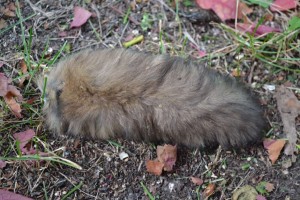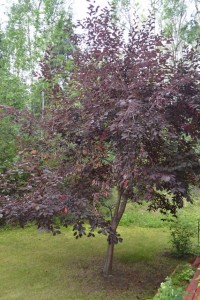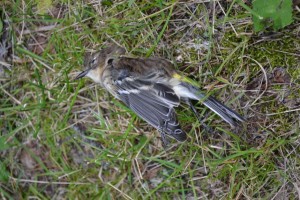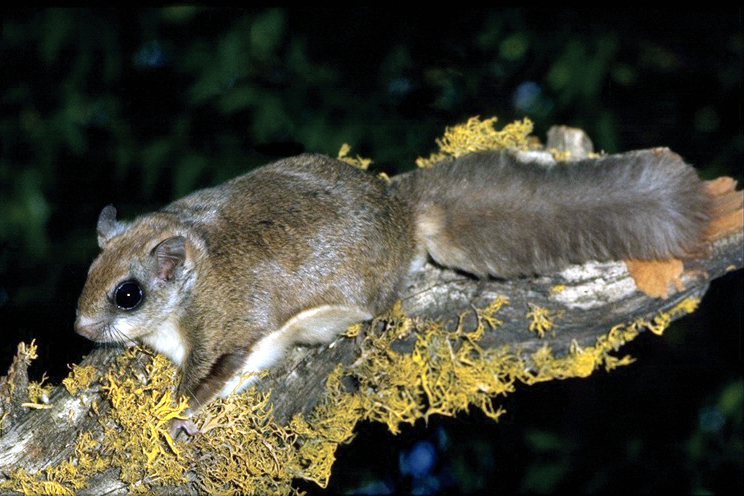This morning under Bird Tree I found the remains of a grisly incident: the tail of a northern flying squirrel. There were no other clues. No tufts of fur, no blood—nothing in fact to indicate whether the whole animal met its demise or whether it only lost an appendage. Who did it? And is the victim still alive?
First, the scene of the crime. What a difference a few days make at Bird Tree. The chokecherries are ripe now, and Swainson’s and Gray-cheeked thrushes are coming in to eat them. The warblers, kinglets, and juncos are still active, too, although Yellow Warblers have already become scarce. The levels of activity are at their annual high. The Tail Tale is not the only brush with death hereabouts. Many birds are getting their first experiences with windows. Most get away after a light bounce, but some hit harder and do not recover. Yesterday, while I watched a red squirrel cache fresh spruce cones, two thrushes fully engaged in a chase bounced off the window in front of my face. All four of us jumped in surprise. A few minutes later the Swainson’s and Gray-cheeked thrushes flew off with what must have been big headaches. Some are not so lucky, however; these get labeled and put into the freezer to take to the museum.
Meanwhile, the nocturnal visitors have to our knowledge only been flying squirrels. A few weeks ago, Andy Johnson and Greg Schmitt were visiting, and as it grew dusky out we saw one of these amazingly fluffy squirrels come in to the bird feeder. To our surprise, it exited the feeder by climbing up the side of the house. The next day, with better light, I could see that this was a well-used exit route for them—a veritable highway of claw marks went up from the feeder. Presumably they left by getting some elevation and then flying across to the nearest tree. It is odd that it took us so long to discover this. In winter it is clear from their tracks that at least in coming to the feeder they hop along the ground like a normal squirrel. But what could have caused one to lose its tail?
Could it have been some unpleasant squirrel-on-squirrel action? While their numbers will be at an annual high, territorial fights seem to be most intense during mating season, which is a long way off. So it’s unlikely that the tail was bitten off in a fight. We haven’t seen any owls around, but they could certainly have picked off a squirrel, particularly at this time of year, when the young and the stupid are still learning the ways of the world. But with a lack of blood in evidence and no other pieces on the ground or in the tree, I am skeptical. In the afternoon, while hauling firewood in from the woods behind the house, I spotted old Reynard, the red fox, slowly walking away from me. He loves squirrel, and it would not surprise me if he were responsible for the tail. But still, no blood. I also saw a cat in the yard a few days ago, so we have another suspect. Could the squirrel have flown into a window and killed itself, to be scavenged later? That might explain a lack of blood, and we did have one window kill several years ago. The mystery remains open!





